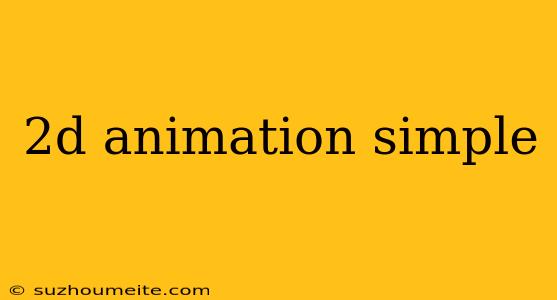2D Animation Simple: A Beginner's Guide
What is 2D Animation?
2D animation is a type of animation that uses two-dimensional objects and characters to tell a story or convey a message. It is a traditional animation technique that involves creating the illusion of movement by displaying a sequence of static images or frames.
Why Choose 2D Animation?
2D animation is a popular choice for many reasons:
- Cost-effective: 2D animation is generally less expensive than 3D animation, making it a more accessible option for indie filmmakers and small studios.
- Easy to learn: The principles of 2D animation are simple to grasp, making it a great starting point for beginners.
- Flexibility: 2D animation can be used for a wide range of projects, from short films to TV series, commercials, and even video games.
Basic Principles of 2D Animation
To create a simple 2D animation, you need to understand the following basic principles:
The 12 Principles of Animation
The 12 principles of animation were first introduced by the Disney animators Ollie Johnston and Frank Thomas in the 1930s. These principles are still used today and provide a solid foundation for creating engaging and believable animations.
- Squash and Stretch: The ability to exaggerate and distort characters' movements and bodies for comedic effect.
- Anticipation: The movement or action that precedes a main action.
- Staging: The presentation and placement of characters within a scene.
- Straight Ahead Action and Pose to Pose: Two different approaches to animating a scene.
- Follow Through and Overlapping Action: The continuation of movement after a main action has stopped.
- Slow In and Slow Out: The gradual acceleration and deceleration of movement.
- Arcs: The use of curved lines and movements to create a sense of fluidity.
- Secondary Action: The use of secondary characters or objects to add depth and interest to a scene.
- Timing: The control of the length and pacing of a scene.
- Exaggeration: The amplification of movements and emotions for comedic effect.
- Solid Drawing: The ability to create a sense of volume and weight in a character's design.
- Appeal: The creation of a sense of charm and personality in a character's design.
The Animation Process
The animation process involves several stages:
- Pre-production: Scriptwriting, storyboarding, and character design.
- Production: Keyframe animation, tweening, and coloring.
- Post-production: Sound design, editing, and final touches.
Software and Tools
There are many software and tools available for creating 2D animations, including:
- Adobe Animate: A popular choice for beginners and professionals alike.
- Toon Boom Harmony: A professional-level software used in many studios.
- OpenToonz: A free, open-source software for 2D animation.
- Pencil2D: A free, open-source software for traditional hand-drawn animation.
Conclusion
2D animation is a fun and creative way to tell stories and bring characters to life. With an understanding of the basic principles and a willingness to learn, anyone can create their own simple 2D animation. Whether you're a beginner or an experienced animator, the world of 2D animation is full of possibilities and opportunities.
